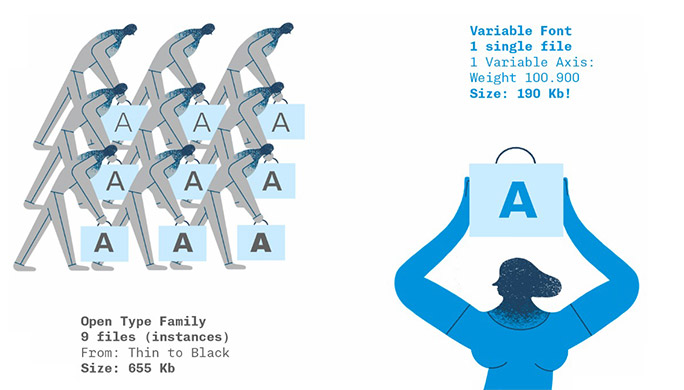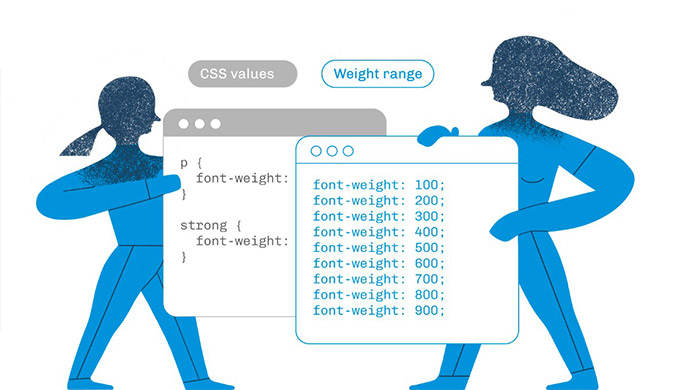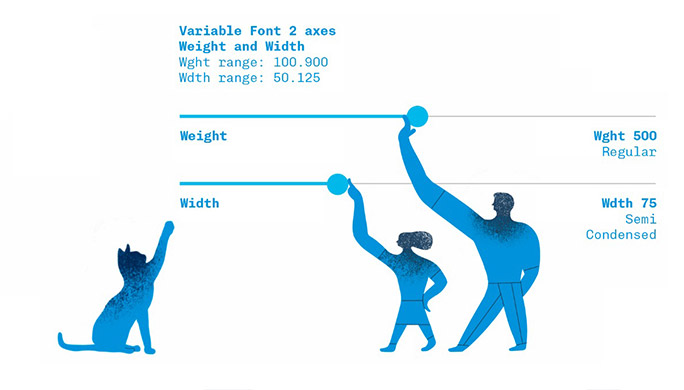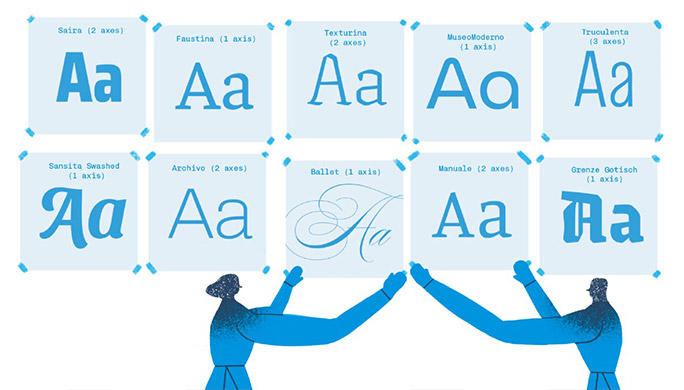
Hello! This is our new collection of variable fonts…
We invite you to learn more about variable fonts, and to enjoy the new collection created by Omnibus-Type, each with a free and open license.
What are variable fonts?

A variable font is a new kind of font which can compress in one single file all its variations, including weight (Light, Regular, Bold, Black), width (Condensed, Normal, Expanded), optical size (Display, Text), and more.
If you need to design a publication, or develop a website, you can download and install them in your operating system and use them in common design applications. In addition to accessing traditional named styles within a typeface family, you can pick custom styles within ranges offered by the typeface designer. If the font has more than one axis of variation, you can combine them – such as choosing your own bold condensed style.
This new feature translates into three direct benefits: To compress, to express, and to finesse. Creating styles within a family dynamically reduces the file size (up to 70% for a large family) and on the web this speeds up page load times. Expressing yourself or your text with custom styles offers interesting new creative possibilities, especially in motion graphics and interactive typography. But the biggest benefit is in the new way to fine-tune editorial typography, with axes like optical size that apply a point-size specific typeface to every text.
Learn more with Google Design.
How to use variable fonts?

You can use variable fonts in your website via the Google Fonts API. You can also self-host variable fonts using a @font-face rule in your CSS, and the font-variation-settings property to access custom styles. If you want to learn more about how to use variable fonts, see web.dev/variable-fonts.
What does this website contain?

This website presents the first collection of variable fonts created by Omnibus-Type. After watching the animations in Home, you can use the Tester to discover the potential of each font’s axes, including weight (wgth), width (wdth), and optical size (opsz). Try out all the different options for composition (size, alignment, color.)
In Font Specs you can read more details of each project (with a brief description, credits, license, awards) and download them directly from us or from Google Fonts. You can also interact with us by sending messages and technical suggestions, sharing information on social media, or making a donation.
Our collection of variable fonts

The collection presented here contains the variable fonts by Omnibus-Type. As well as offering appealing formal options for your projects, we hope to facilitate the production and publication of lighter, dynamic, and striking websites.
All the fonts are available with the SIL Open Font License, which allows free use no matter if your project is commercial or not. According to the amount of axes, the list begins with the 1 axis: MuseoModerno (wght), Grenze Gotisch (wght), Sansita Swashed (wght), Faustina (wght, plus italics), Manuale (wght, plus italics), Rosario (wght, plus italics) and Ballet (opsz); 2 axes: Texturina (wght & opsz, plus italics), Saira (wght & wdth, plus italics) and Archivo (wght & wdth, plus italics); 3 axes: Truculenta (wght, wdth & opsz).
We invite you to get to know them and try them out in your next project. We hope you enjoy the experience… and we hope you will join us as we carry on developing new wonderful font projects.
Thanks to Romina Aráoz (AR), Henrique Beier (BR), Yorlmar Campos (VE), Aldo de Losa (AR), Rafael Dietzsch (BR), Lucía Domenech (AR), Teo Fumagalli (AR), Julián Gak (AR), Héctor Gatti (AR), Mercedes Jáuregui (AR), Emma Marichal (FR), Daniel Roldán (AR), Guillermo Torres Carreño (CO), Alejandro Sanchez Menendez (AR), Eduardo Tunni (AR) and Rosalie Wagner (FR) for their great commitment, and for sharing their talent in each stage of the Omnibus-Type project.
Resources:
- Introduction to Variable Fonts (web.dev)
- Google Fonts Information Table (families, axes and values)
- Google Fonts Documentation (CSS API update)
- Google Fonts Catalog (families and variable fonts)
- Omnibus-Type Catalog (variable fonts)


